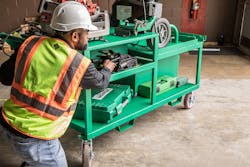It’s safe to say that all electrical contractors want a stimulated economy. They also all want projects. Now that the economy is performing, however, many can’t manage the work. Unfortunately, a mission-critical challenge remains — the lack of skilled labor in the trades.
I know an electrical contractor who was approached recently by a general contractor (GC) for a bid he didn’t want to submit. He did it anyway — bidding the job at a reasonably high margin. However, when the GC called to award him the bid, he felt an immediate sense of panic because he wasn’t sure how he would man the job. As the construction industry as a whole (and the electrical trade in particular) continues to exhaust the skilled labor workforce, this is becoming an all-too-common scenario.
As we enter 2019, the skilled labor shortage isn’t the only pain point contractors will face. For example, lack of knowledgeable and experienced workers can lead to additional injuries on the job site. In addition, the materials used in project bids two years ago now cost 20% to 30% more due to tariffs on steel and construction products. There is also added worry over rising interest rates. These factors are leading many to believe that the market will flatten in 2019. Fortunately, numerous solutions exist to address these potential challenges head on.
Revamping the Intake Process
In the electrical industry alone, the labor shortage is expected to reach 200,000 apprentices in the next five years. To mitigate the gap, companies are looking at creative tactics to get trained people in the workforce, such as:
• Early recruiting. Trades are holding job fairs at elementary and junior high schools with hopes of attracting youths.
• Reducing the duration of apprentice programs. The electrical industry is evaluating the impacts of reducing the five-year apprentice program to four years, effectively allowing apprentices to become journeymen one year early.
• Applying life experiences to credit hours. If a person worked a trade in the military, he or she could transfer that on-the-job experience to count for credit hours. This would help move the apprentice through the program to become a journeyman more quickly.
Although not all trades are using these tactics to alleviate the workforce shortage, they’re exploring them as potential options.
Reduce Wasted Time
Established industry benchmarks suggest that approximately three hours of an eight-hour workday (nearly 40% of that time) are spent unproductively. Those of us who have worked or currently work on a job site shouldn’t be surprised by this statistic. A lot of waiting occurs in construction — waiting for materials, waiting for a tool, waiting for other trades that are in the way to move, etc. Wasted time further compounds when workers have smartphones on the job site or when workers have to walk to restrooms or water stations. There is a silver lining: Software is going to make construction more productive, and those who don’t embrace its advantages will be left behind.
The solution can be summed up in one word: fabrication. It’s the buzzword that isn’t going away — and for good reason. Fabrication is the answer to increasing margins, reducing inefficiencies on the job site, and improving worker safety. For the electrical industry, this requires a paradigm shift of mindset, requiring contractors to move away from the question of “what can we build on the job site?” to “what do we have to build on the job site, and what can we build first in a shop?”
The foundation of fabrication is a process known as building information modeling (BIM). The 3-D modeling technique is not new to the construction industry. The United Kingdom has mandated that all new buildings must be constructed using BIM and fabrication after the country saved nearly 20% on construction costs between 2009 and 2015, according to the Thomas Index Report from May 2018. In the United States, government’s General Service Administration (GSA) created a mandate in 2003, stating that all new government public buildings must be constructed using BIM.
The cost-effective streamlining process is showing dividends for Los Angeles Community College District (LACCD). In 2001, LACCD launched a $9.6 billion voter-funded building program to renovate and/or construct nine buildings to support educational advancement in the area. All the projects require the use of BIM and fabrication. Of the 911 projects on the plan, 663 projects (as of
Dec. 11, 2018) are complete, and BuildLACCD.org estimates that nearly $27 million will be remaining from the funds.
With all the cost and time savings of fabrication with BIM, why has the electrical industry been slow to adopt it? Until recently, tools did not exist to help electrical contractors seamlessly and confidently adopt the process of using BIM to execute fabrication. The data collected through BIM is designed to flow smoothly through everyone involved in the project. Electrical contractors create a disconnect when they jump to the BIM model without any input from the individuals at the job site or those working in fabrication. In a smooth BIM process, no information gets lost along the way. A well-managed BIM process in the fabrication environment should make jobs easier for BIM coordinators, electricians, fabrication shop supervisors, and job-site foremen. When BIM is implemented correctly, contractors finish the job efficiently and win more jobs to maximize profit.
Fabrication ROI
In the United States, the electrical industry doesn’t yet know the ROI of implementing fabrication, but we do know how to figure the ROI of risk mitigation by calculating the potential experience modification rate (EMR). One could argue that if there are fewer workers on the job site, there is less risk of someone getting hurt. This could also result in a better EMR number, which, in turn, lowers insurance rates. When workers report to a fabrication shop instead of to a job site, they face fewer potential hazards and ultimately the project can realize potential cost savings.
In a fabrication environment, accountability is increased. Through productivity progress reports, contractors can track the flow of operations and who is assigned to the task(s). Fabrication can also eliminate an ongoing headache on the job site: clash. When engineers underestimate electrical space needs, there may not be enough room to run conduit around ductwork. Engineers must redesign the space, which leads to downtime where nothing gets done. This results in delayed completion dates and profit loss.
Fabrication fosters consistent quality. While engineered designs aren’t always perfect and sudden changes impact materials that were originally ordered, workers in a fabrication facility typically are in a controlled environment that follows specific standards. Since there is opportunity to perform quality checks on-site, workers develop more experience in the task that they’re accomplishing. Routine progress reports enable conflict resolution earlier in the project rather than on the job site, which could cause further delays due to rebuilds, schedule conflicts, etc.
Finally, fabrication environments are designed to reduce construction time and scrap. Building off-site in an enclosed environment decreases delays due to weather. It also allows multiple jobs to be performed simultaneously under one roof. And, because workers are completing tasks that meet exact measurements and standards, scrap is reduced.
Implementing Fabrication
Construction companies that want to be profitable in the future need to lay the groundwork to adopt fabrication now. The most important part of adoption is the necessary culture shift that must take place. The right tools and modeling software are also imperative to eliminating rework in the field. Having these in place will only support the buy-in process from the whole team. Here are a couple of steps you can take to get the ball rolling:
• Schedule regular meetings with teams to discuss the process and fully explain why the change is integral to a project’s successful completion.
• Enlist qualified consultants to layout efficient workflow and lean principles for a productive fabrication shop. Lean principles work to breakdown traditional silos by providing shared knowledge among all parties assigned to the job.
Understand that electrical fabrication sites foster the successful completion of a whole host of tasks, such as: planning and design activities; storage, protection, and transportation of raw materials and fabricated parts; efficiency in conduit bending, shearing strut and threaded rod, cable and wire preparation, termination and management, and pre-punching holes; and, as discussed previously, better quality control.
To mitigate the skilled labor shortage, 2019 needs to be the year of change for contractors, which means either embracing off-site fabrication or competing against it. In a high-performing economy, no one should pass on bids because they’re fearful of not having a skilled workforce.
Smith is the director of strategic contractor relations at Greenlee, La Jolla, Calif. He can be reached at [email protected].




